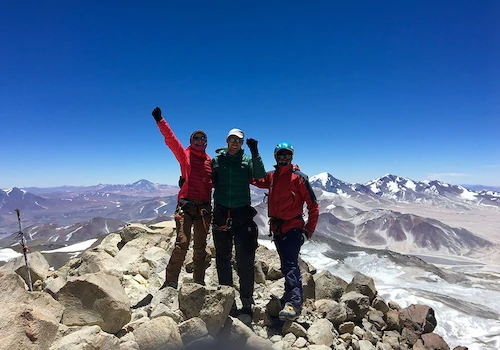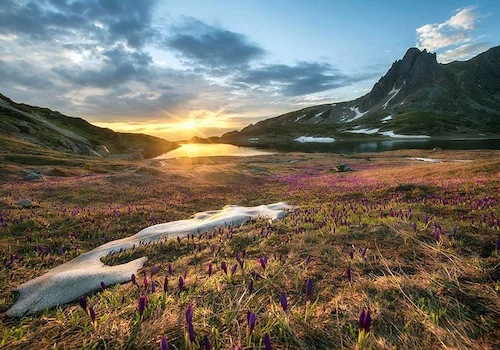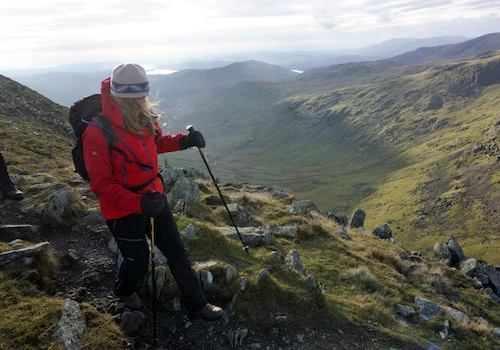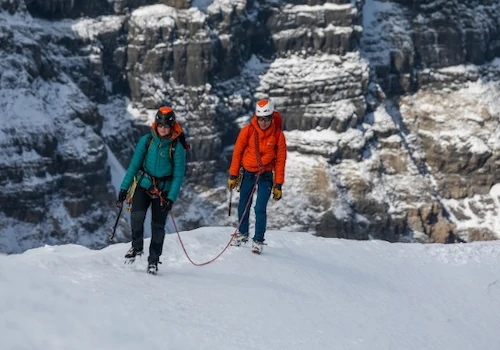
- Expeditions
By Region
By Month
By Grade
By Height

- Treks
- UK & Alpine
- Schools
- Hire
- News
- Shop
- Contact
Denali West Ridge Expedition 15th May 2010

Team: Duncan Hale, Steven Marin, Robert Kerr, Ernie Clark, Jean-Phillippe Pepin
“The team is all now safely out of the Alaska Range and appears to have made a strong effort toward replenishing their energy supplies last night. I’d have to say it appears they must have been a bit dehydrated, judging from the quantity of fluids on that table. Good on them!
They did really well and kept a great attitude throughout a long expedition. They had loads of different weather to deal with and they did a fantastic job up there”.
2nd June – Zac just called in 20 minutes ago to report that seven team members and two guides reached the summit of Denali yesterday. It sounds like everyone did well, and they are currently packing up their high camp and getting ready to head down to Base Camp!
They should arrive at BC tomorrow, and we’ll keep you posted as we learn more about who summitted and how they are all doing on the descent.
The unofficial word from the mountain is that the expedition summitted yesterday, but we haven’t heard from him directly yet as to who made the top, if not everyone- when he calls with details I’ll write an update. More soon……
4th June -Zach left the following message minutes ago. The weather at the airstrip has not permitted the team to fly out, so they are in a sort of “hurry up and wait” state…
There is a Base Camp manager who monitors the conditions in the Southeast Fork of the Kahiltna, where the airstrip is located. She has a radio phone connection to the air taxi services in Talkeetna as well as VHF radio contact with the planes flying overhead. She is the de facto air traffic control in a manner of speaking, and has a keen sense of when it is safe to fly. Our guides have a habit of bringing her fresh fruit and flowers in an ongoing effort to keep us on her good side!
3rd June -We just got a relay from another MT team at basecamp- Zach and company are about an hour from the airstrip and are looking to fly to Talkeetna today.
1st June -Zach called yesterday to report another day waiting out the weather at high camp, still dreaming of that window of acceptable weather. Zach spoke of the common scenario often seen on the West Buttress: several teams leave for the summit in marginal or deteriorating weather but Mountain Trip groups decide to wait in camp; we call it the human factor.
Many groups are waiting for the weather window at high camp and there are many days where the conditions aren’t great but not so terrible that a decision to try for the summit would be an obviously bad idea, so inevitably a team of climbers will try for it. Seeing other climbers go for it can override caution and force the decision process in inexperienced groups- once one group goes for it the gates are opened and other teams invariably follow; this is the human factor.
It can be hard for MT team members to watch other parties move up Denali Pass while remaining in camp. MT guides have seen this process over and over again on the West Buttress and elsewhere in the mountains, and experience on the mountain makes for confidence in decisions so Zach will continue to be the good guide and patiently wait, and all the while making soup and hot drinks for the expedition and keeping one eye on conditions up high. All MT guides on the West Buttress have seen parties leave for the summit in bad conditions and come back with frostbite or worse, but injuring yourself for the summit is ugly style and not part of the Mountain Trip ethic. Most often the conservative decision is the right decision.
31st May -The weather looked good enough in the morning to load up and head out for a summit foray, however; Zach left this message last night after they were turned back with increasing winds.
Summit day decision making can be truly agonizing. Often the weather looks like it is trending toward a good day, but then the mountain decides that it’s time to blow again, and the summit window closes. Everyone has their own personal acceptable level of risk, the parameters of which are forged with their own ambition and egos. It is our job as mountain guides to apply a reasoned set of decision making protocols to the choice of when and if to head for the summit.
Our number one priority is that all of our climbers return home healthy. We also want everyone to have an amazing time with us in the mountains, but we are not willing to sacrifice these goals for the sake of ambition. Frostbite still occasionally occurs, but heading to the summit in high winds will pretty much guarantee that someone damages their fingers or toes, and we have a deep affinity for those appendages, so we’ll make conservative decisions.
The team has plenty of time, food and fuel. It looks like today could be a summit day, but there do appear to be lenticular clouds above the summit of Mount Foraker and covering the top of Denali. Keep your fingers crossed!
30th May -The team spent yesterday relaxing at high camp, drinking rounds of hot drinks and eating a mix of heavy but delicious breakfast food (reportedly bagels with bacon and cheese) and standard altitude fare (Mountain House freeze dried meals). Eating at altitude is always a challenge, and there is a lot of dubious information about what a climber should and shouldn’t eat at altitude, but it seems that the best menu strategy is the one that has lots of food folks actually want to eat. Decreased appetites make people think they’re full before they have replenished calories, and bacon and cheese bagels sound much more appetizing than instant oatmeal packets. Zach opted to bring six days of food from 14 camp, so the group has food security while they sit pretty and dream of the summit push. The weather looks good on the Talkeetna Air Taxi webcam, but it is located in Talkeetna; what looks good from town often isn’t good in the mountains, so we’ll wait and see how things turned out today.
29th May -Zach called in last night to say that the group had completed the big move from 14 camp to their high camp at 17,000′. A rest day at 14 camp let the group gather their strength and yesterday went off without a hitch; it is a big day and requires big effort, but they are right now probably just stirring out of their sleeping bags and waiting for the first round of hot drinks from the guide’s tent, Zach planned another rest day for today to recuperate and prepare for the summit attempt. Zach reported a few blisters but nothing drastic- big, clunky climbing boots don’t alway agree with climbers’ feet and blisters usually only become a problem if left unattended. High camp can be a severe place to hang out so the team is settled into the most fortified camp of the West Buttress- thick snow walls help break the force of the winds, which can sometimes blow to hurricane force or more.
The team left their cozy kitchen tent at 14, so now the guides cook in the vestibule of their tent. Although the kitchen tents are nice, they have a hard time standing up to bad weather and aren’t worth the weight. The colder temperatures usually mean people are greatful to get their food served to them in their sleeping bags- breakfast and dinner in bed!
26th May -The team was out of contact for a few days, I believe there was technical difficulties with the satellite phone which have been resolved…..Zach called this afternoon to report their progress; the team finally got their weather window and moved to 14,000 camp. Most of the team carried a load up the fixed lines today and established a cache at 16,400′ and then descended again to camp. The fixed lines are the first steep terrain the expedition has encountered. This year, what is sometimes a snow slope is a blue ice slope, polished by high winds and a relative lack of precipitation; it is hard work to climb with a heavy pack, so the National Park Service has for years fixed lines on the slope so climbers can clip into it with ascenders. Having ascenders on the line means if anyone was to slip they have a safety rope to check any fall. Above the fixed lines is the beginning of one of the most aesthetic parts of the West Buttress, the ridge between the top of the fixed lines and 17 camp; most Mountain Trip groups move up this ridge for 400 to 500′ and dig a cache hole.
The carry day is important for acclimatization- our teams heed the mountaineer’s adage ‘climb high, sleep low’, which spurs the body to adapt to the higher altitude but allows it to recuperate in the thicker air at 14 camp. Tomorrow is a planned rest day, during which the team will gather its strength for the big move to 17,000′ camp. More soon, thanks for standing by…..
23rd May -Strong day today, Zach sez- the team carried a load of supplies up from 11 camp to a cache at 13, 500′. Their day involved moving up Motorcycle Hill right out of 11 camp, climbing below Squirrel point (so named because climbers reportedly found a squirrell living in the area subsiding off old food caches) and moving across the Polo fields to Windy Corner. Once around the corner they negotiated a crevassed but mostly flat stretch that leads to a sheltered spot where most parties cache their gear. There are lots of names for the features in the area, a testament to the long history of climbers on the West Buttress. Zach said conditions were a little blustery around Windy Corner but very pleasant at the cache, and the team is still feeling strong. This day is typically the first that climbers feel the altitude and it is common to have the first altitude headache of the season when they return to 11 camp.
A message from the field from Steve to Pam: Steve hopes everything is OK.
22nd May -Zach just called in a report that high winds near Windy Corner convinced them to hang out and take a res and acclimatization day at the beautiful 11,200 foot camp.
A lesser known fact is that any altitude on Denali is actually the equivalent of a higher altitude on a peak at a lower latitude. This is because the centrifugal force of the earth’s rotation causes the atmosphere to bulge out along the equator and is essentially “pulled” closer to the poles. This makes the summit of Denali feel more like a 23,000′ peak near the equator. Therefore the acclimatization benefits of spending an extra day at 11,200′ are actually very beneficial.
Zach took advantage of acceptable meather to move from 7,800k to 11k camp yesterday. The move signals the end of their ascent on the Kahiltna, after 11k the climbing takes the team onto the Denai massif itself. He reports a continually strong and motivated team; people are excited to leave their sleds and snowshoes behind and start cramponing towards 14k camp. If the weather is acceptable the team will carry loads today, stay tuned for updates this evening.
20th May -Zach checked in last night from 7,800k after dinner. Although the satellite phone cut out a few times (quite common) I was able to get clued into all the other Mountain Trip groups on the mountain. Because of its location, 7,800k can become an information hub; all Mountain Trip groups get on the FRS radio after the 8pm weather forecast that the basecamp coordinator puts out every evening, and sometimes instead of everyone reporting in to the MT office separately via sat phone everyone will relay their information to the office through one person.
Zach and company carried up Ski Hill almost to the base of Kahiltna Pass and cached around 10,400k. He spoke of building clouds and snowfall, reporting a foot of accumulation but such weather is common on the Kahiltna- that’s where the glacier comes from!
If all is well his plan is to move to 11k camp, which takes five to seven hours but puts the group above Kahiltna Pass and off the main flow of the Kahiltna. This puts them above the often daily, localized bad weather phenomenon that plagues the glacier from 9k to 10.5k or so. The TAT webcam shows some buildup in the range but the forecast is for better times.
19th May -Zach reported via satellite phone last night to say they had easily moved to 7,800k camp yesterday, and spoke of ‘moving strong’. The move from basecamp to 7,800k is not too challenging terrain-wise, although the glacier is crevassed and the distance long; our team single-carried which means they carried all supplies for the entire expedition in one go from basecamp. This seems like a lot of weight (often too much) but if they had carried and then moved in two separate stages the work load would be more overall than a single-carry.
From 7,800k they will begin carrying loads of supplies ahead of camp to avoid carrying crushing weight as the route begins to gain more elevation from this camp on. Zach has been a raft guide for years as well as a mountain guide, and those raft guides sure know how to cook a meal- last night they had Tortellini with artichoke hearts with parmesan plus lots of soup and hot drinks. They plan to carry supplies ahead today and return to camp for another big meal.
The crew at the Park Service office, waiting for their orientation.
Zach sent me this photo of the team, loaded up and ready to head to Talkeetna.
They will drive about 2.5 hours north of Anchorage, stopping for a bite to eat and to refuel on coffee. Upon arriving at the sleepy village of Talkeetna, they will drop their gear and supplies off at the airstrip and continue to the National Park Service headquarters to register with the NPS. Each Denali team is also required to attend an orientation, presented by an NPS Ranger, that outlines proper mountain etiquette and helps climbers better understand the dangers of climbing a big mountain like Denali.
After the NPS stop, they will head back to the airstrip where every piece of gear and every food bag needs to be weighed for the flight into the Range. The staff at Talkeetna Air Taxi does a great job of helping us get our climbers organized and into their aircraft for the amazing 45 minute flight into Base Camp.
The weather looks pretty good for flying today, but it is by no means a bluebird, clear day, so let’s keep our fingers crossed that the team can fly onto the glacier.
Standing by…
17th May -Thanks to Tom Lynam for bringing along a SPOT GPS location tracker.
The SPOT unit will transmit its coordinates to the SPOT website, which will post its location on a dedicated web page. This will allow you to follow the team’s progress on one of several Google Maps. Check out the terrain or satellite maps!
Thanks again Tom!
16th May -The May 16 West Buttress expedition members all met each other today for the first time at the Earth Bed and Breakfast in downtown Anchorage. The guides Zach and Adam met all nine climbers and spent the morning checking gear; the third guide Luke was unavoidably detained out of state but will meet the group tomorrow morning.
Zach spent an hour familiarizing everyone with the general format of the expedition, talking about everything from nutrition to rope travel basics to expedition schedule, before passing out the lunches for the entire expedition. Zach favors a system where people have the option to see what lunch food they’ll be taking on the mountain and adjust their lunch menu to their personal taste. Expedition nutrition is a very important aspect of every expedition; because of the workloads involved in Alaskan mountaineering, climbers need to take in more food to replace what they are burning while carrying loads and just plain keeping warm in the cold mountains. The altitude can make this difficult because it affects many people’s appetite, so as you need more food it becomes harder to take it in. Zach, Adam and Luke have decades of experience in backcountry kitchens between the three of them and they have assembled a very tasty menu, so folks on this trip shouldn’t have any trouble eating enough to stay energized on this trip.
A quick visit to the local climbing shops brought everyone back to the B+B for a final bout of rigging packs for glacier travel before separating for what may be their last night in town for two to three weeks….
There was a scare involving a lost bag at the airlines that made it seem as if the team may have had to wait a day for it to show, but Zach persevered and refused to believe Alaska Airlines when they told him the bag wasn’t in Alaska- he pulled off a major save by going to the airport and locating the bag himself. The team will be departing Anchorage as scheduled tomorrow morning to drive to Talkeetna, hop on one of Talkeetna Air Taxi’s flights and fly into the majestic Alaska Range!
15th May – Thanks for joining our dispatch blog for our May 16, 2010 West Buttress of Denali expedition.
A group of climbers from around the world will assemble in Anchorage, Alaska to meet three guides from Mountain Trip in preparation for an attempt of the highest peak in North America.
Rising to a higher vertical relief than Mount Everest, Denali (Mount McKinley) dominates the impressive Alaska Range, soaring 20,320 feet above sea level. It’s proximity to the Arctic Circle makes for some of the most challenging weather conditions on the planet, and, also due to it’s norther latitude, Denali “feels” like a much higher mountain, as the earth’s atmosphere is quite a bit thinner so far north. Any attempt of Denali is often the challenge of a lifetime for most climbers.
Let’s meet the climbers!
Guides:
Zach Johnson of Anchorage, Alaska
Adam Smith of Anchorage, Alaska
Luke Smithwick of Girdwood, Alaska
Climbers:
Tom Lynam
Dan Healy
Duncan Hale
Steven Marin
Robert Kerr
Ernie Clark
Scott Holder
Jean-Philippe Pepin
Claudio Campori
We will do our best to post updates on a daily basis, but please keep in mind that any number of things could interfere with any given update being posted. The climbers are excited about calling in, but they need to keep their focus on the task at hand, and might not break out the satellite phone each evening, weather and terrain features could conspire to prevent phone calls from going through, etc, etc, etc…
Bear in mind the age-old axiom, “No News Is Good News!” For some reason, sup-optimal news always seems to get out from the mountain, while the exciting update of lounging in the sun, eating reindeer sausage quesadillas sometimes takes a day to filter through to our office.





